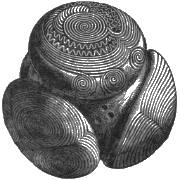NMS Archaeology Object 642638: X.2005.27.4 - Pottery / food vessel / portion
Description
Summary
Food vessel comprised of 12 sherds with an everted rim and broad internal bevel, from Holly Road, Leven, Fife
Accession Number
X.2005.27.4
Other references
| Classification number | X.EQ 1116 |
|---|
Original description
[One of] Finds from excavations at Holly Road, Leven, Fife. ORF: IDENTIFICATION - Description: Finds from excavations at Holly Road, Leven, Fife. X.2005.27.4 (X.EQ 1116): Food Vessel. Description (after published catalogue entry by Sheridan): This pot comprises twelve sherds, now conjoined, forming over a third of a bipartite Vase Food Vessel with a stopridge groove on its shoulder. The rim is everted and has a broad internal bevel and narrow external bevel; the neck is upright and gently concave. The stop-ridge is narrow (approximately 4mm wide) and sharply defined; the tool has left striations in the groove. The stop-ridge is interrupted by one extant strap-lug; there would originally have been four. The lug is narrow and unperforated (and thus non-functional in terms of suspending the pot) and had been made by leaving clay on the shoulder at this point, rather than gouging it away. Below the stop-ridge, the belly narrows evenly towards the base, changing direction almost imperceptibly just above the wall-base junction to form a pedestal; the base is flat inside and outside. The whole of the exterior surface (except the stopridge groove and the area just above the base) and the internal rim bevel are decorated with impressions made using fairly fine cord, between 1.5 and 2.5mm wide. These become increasingly shallow from the stop-ridge to the bottom of the wall. Short, vertical whipped cord ‘maggots’ (made by tightly twisting the cord or wrapping it around a flexible core) occur on the external rim bevel, the edges of the stop-ridge and the extant strap lug. Plain lines of twisted cord impressions occur as five concentric lines on the internal rim bevel; as two horizontal lines at the top of the neck, and two at its bottom; and as two horizontal lines at the top of the belly. Elsewhere, the decoration consists of a herringbone design of twisted cord, fading out at around 10–15mm above the base of the pot. The exterior and interior surfaces are a light reddish brown and the core is blackish; this indicates rapid firing. A small grey-brown patch (more of a stain than an encrustation) on the interior at stop-ridge level could conceivably represent the final traces of the pot’s evaporated former contents. The exterior surface has been carefully smoothed to conceal the crushed stone temper, and both exterior and interior surfaces may well have been coated in a self-slip (a slurry made from the clay used to form the pot) prior to decoration. The slip has cracked, leaving a network of hairline cracks over the surfaces. The fabric is hard and the deliberately-added temper comprises angular fragments of a speckled, black and white crystalline rock up to 4 x 3.5mm in size, at a density of about 10%. There are two unintentional impressions on the interior surface, possibly of a material such as straw; they do not seem to be cereal impressions. Dimensions: height: 140mm; rim diameter: 150mm; base diameter: 70mm; thickness: 7-16mm. Context: found on top of subsoil a short distance SSW of Cist A – but the location of the cist in which it had been buried is not known. The fracture surfaces are all fresh, probably as a result of the machine-stripping of the area during its evaluation in May 2002. FIELD COLLECTION - Place: Holly Road, Leven, Scoonie (Kirkcaldy), Fife. Grid Reference: NO 3783 0213. Site Type: Cist cemetery. Period: Bronze Age. Method: Excavation. NMRS no: NO30SE 1. Circumstances of Discovery / Notes: Excavations were undertaken in advance of the development of an area to the N of Leven where a cist burial was discovered in 1944. The recent investigations revealed an enclosed cist cemetery, radiocarbon-dated to the first two centuries of the second millennium BC. The cemetery appears to have had a short period of use when it received inhumation burials inside the ditched enclosure. A number of cists of poorer construction were uncovered outside the enclosure and a Neolithic cremation deposit was retrieved from within the ditch (Author’s abstract). In addition to the fusiform bead from the 1944 investigations (already registered as NMS: EQ 944), the cemetery produced the following: in Cist A were a flint knife, a fossil crinoid that had been used as a bead, and a Vase Food Vessel; in Cists B, C and K, one Vase Food Vessel each (with parts of two others being found in disturbed positions); and in Cist H, an unusually-shaped pebble that had probably been used as an amulet. NOTES and DOCUMENTATION - Bibliographic Reference: Christie, R L 'Short cist at Durie, Scoonie, Fife', Proc Soc Antiq Scot, 83 (1948-9), 230-1. Lewis, J and Terry, J ‘The excavation of an early Bronze Age cemetery at Holly Road, Leven, Fife’ Tayside & Fife Archaeological Journal 10 (2004). Registered / Completed By: Trevor Cowie. Date: 28.8.2006.
Associated person/people (e.g. excavator/former collection)
None
Discovery / field collection
Date of discovery
2002
Method (e.g. excavation)
Excavated
Place (i.e. location of discovery)
Leven, Fife, Scotland, Northern Europe
Grid reference
Not recorded
Acquisition
Acquisition date
2005
Acquisition source (i.e. name of donor)
Unknown
Acquisition source role (e.g. donor)
Donor
Image
None
Identifiers and Links to Other Records
Would you like to help find more links?
| Identifier / External Link | Linked Record | Status | Comment |
|---|---|---|---|
| Canmore Site Id: 31321 | SILLERHOLE, CARAVAN PARK - SCOONIE (KIRKCALDY) - CEMETERY (PREHISTORIC), CIST(S) (BRONZE AGE), CREMATION (PREHISTORIC), HUMAN REMAINS (PREHISTORIC), BEAD (JADE )(PREHISTORIC), BLADE (STONE)(PREHISTORIC), FOOD VESSEL (BRONZE AGE) | Definite | |
| NMS Accession Number: X.2005.27.4 | No linked record | Identifier supplied by NMS |
This area is visible only to logged in users.
